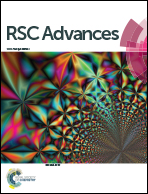One-pot synthesis of lotus-shaped Pd–Cu hierarchical superstructure crystals for formic acid oxidation†
Abstract
In this study, bimetallic Pd–Cu hierarchical superstructure crystals were successfully synthesized using an aqueous solution method. SEM, TEM, XRD and element mapping analysis were used to characterize the structural features, and the composition was determined by ICP-OES. The electrocatalytic activity of these Pd–Cu hierarchical superstructure crystals exhibited enhanced electrocatalytic activity for formic acid oxidation compared with that of commercial Pd black and commercial Pt black. The peak current densities and mass current value of the Pd53Cu47 nanoalloys were 5.3 mA cm−2 and 0.43 A mg−1. For commercial Pd black, these values were 1.18 mA cm−2 and 0.28 A mg−1, and for commercial Pt black, they were 0.85 mA cm−2 and 0.21 A mg−1. Moreover, the current–time tests showed that the Pd–Cu hierarchical superstructure nanoalloys were more stable than commercial Pd black.


 Please wait while we load your content...
Please wait while we load your content...